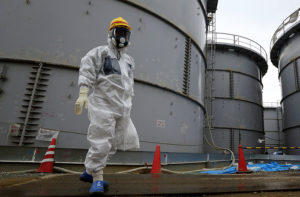According to the company’s materials, the concentration of tritium in the water to be discharged is 55-77 becquerels per liter, which is significantly less than the established standard of 1,500 becquerels per liter. The total volume of water released from the emergency Fukushima-1 nuclear power plant in Japan during the 2023 fiscal year, which ends on March 31, 2024, will be 31.2 thousand tons with a radioactive tritium concentration of 5 trillion becquerels.
The concentration of tritium in water purified from radioactive particles, which is discharged from the Japanese nuclear power plant “Fukushima-1”, is 952 times less than the permissible safety standard established by the International Commission on Radiological Protection and the Japanese government. This is evidenced by TASS calculations made on the basis of data published by the station operator Tokyo Electric Power (TEPCO).
On August 24, the TEPCO company began discharging water into the ocean, which had previously served to cool damaged reactors, and then was purified in the ALPS system. The system allows you to clean it from 62 types of radionuclides with the exception of tritium. This water is stored in giant tanks on the station premises. To date, almost 90% of their volume of 1.37 million tons has been filled.
The purified water is discharged at a distance of 1 km from the shore through a constructed underwater tunnel. The discharge rate is 460 tons of water per day. Moreover, each ton is pre-diluted with 1.2 thousand tons of clean sea water.
More than 1.25 million tons of water accumulated in tanks on the territory of the nuclear power plant, which was used to cool reactors damaged by the tsunami in March 2011. The Japanese government says the water is generally free of radioactive substances and contains only the hydrogen isotope (tritium). In April 2021, Tokyo decided to release a significant portion of this water into the ocean. Before discharge, the tritium content in it is adjusted by mixing with clean sea water to one-fortieth of the safety standard established by the International Commission on Radiological Protection and the Government of Japan, and one-seventh of the permissible standard established by WHO for drinking water.
Despite claims from TEPCO and the Japanese authorities that the release of water does not pose a threat to the environment or humans, China and a number of other countries have sharply criticized such actions. In particular, the PRC banned the import of all Japanese marine products and strengthened customs controls on other products from Japan. Rosselkhoznadzor also announced on October 16 that it joins China’s restrictive measures regarding the supply of fish products from Japan.
French and Japanese scientists have found that more than two-thirds of the initial cesium emissions that entered the land regions of Japan after the accident at the Fukushima nuclear power plant were concentrated in soils in the forests adjacent to the plant. They could become a serious source of cesium pollution in the future, TASS reports, citing an article in the journal PNAS.
Analysis of samples showed that cleaning 16% of the Mano River basin led to a 17% decrease in the concentration of cesium radioisotopes in the soil, which indicates the non-zero effectiveness of the measures taken by Japan. On the other hand, scientists found that about 67% of the total volume of cesium deposited on land after the nuclear power plant accident ended up in adjacent forests, where soil cleanup was not carried out due to the high cost of such work or the impossibility of carrying it out.





